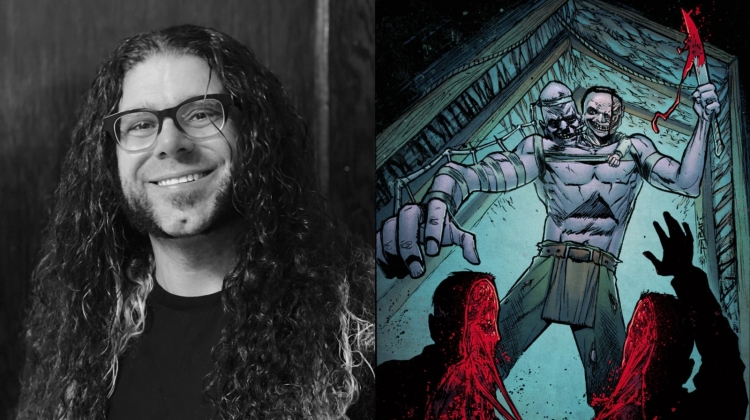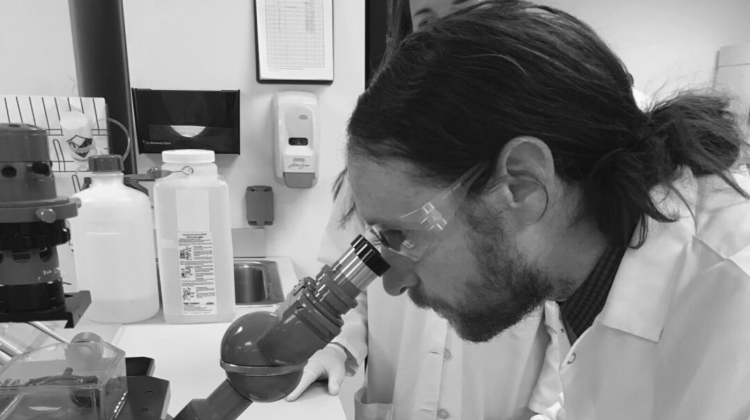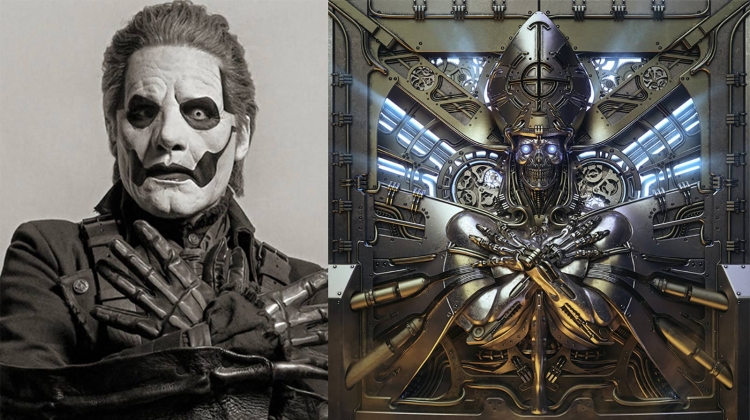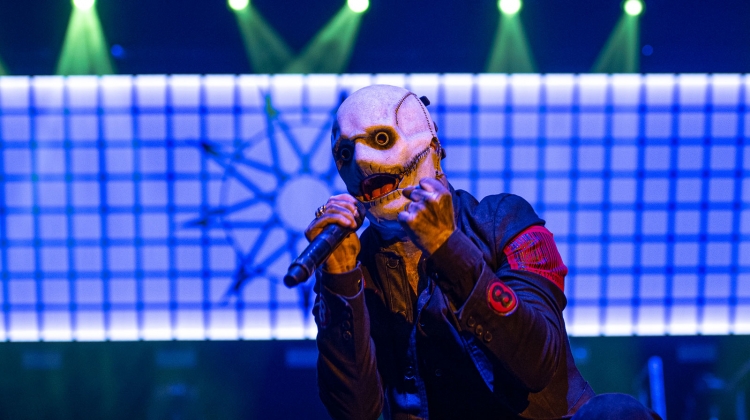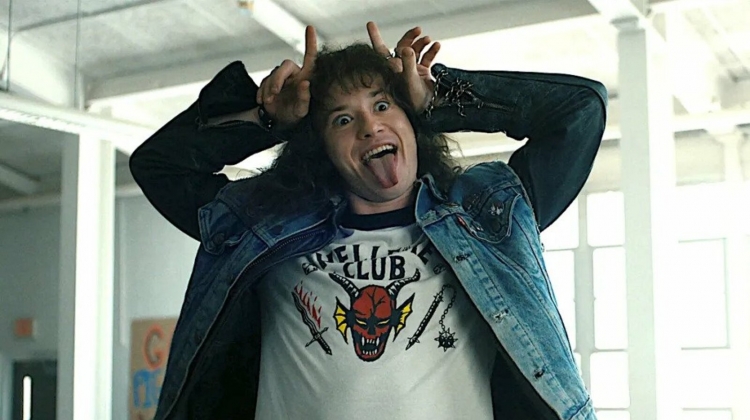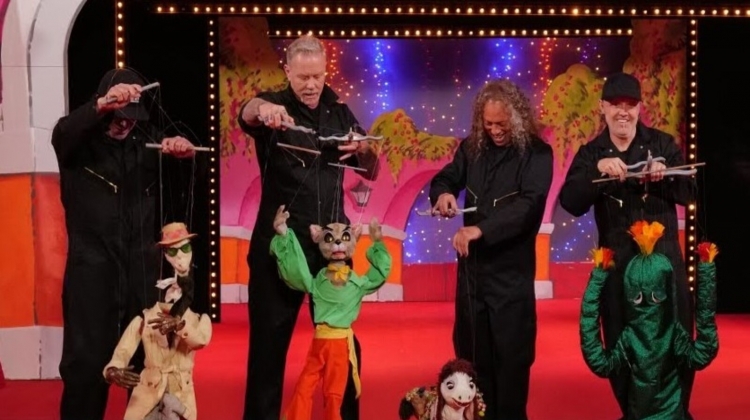Pick up Claudio Sanchez's My Brother's Blood Machine with exclusive, limited-edition covers at Revolver's shop.
When you call your comic book My Brother's Blood Machine, odds are good you're filling those pages with some serious carnage. That's exactly what Coheed and Cambria vocalist-guitarist Claudio Sanchez did with his recently concluded six-issue mini-series — a collaboration with writer Steve Niles (30 Days of Night) and illustrator Andrew Ritchie. Set in upstate New York in the late 1960s, the story revolves around siblings Butchie and Long-Arm, a pair of misguided, misshapen miscreants flinging townsfolk into the titular blood machine, a Rube Goldberg-style contraption of cogs and spikes that strips souls out of their victims' bodies as an offering to God. Funnily enough, the Brothers Bleam are somehow the lesser of two evils in the book.
"When I think of Blood Machine, the real monster of the story is Arthur McCloud," Sanchez tells Revolver over Zoom from a Coheed and Cambria tour stop in Cleveland. He explains that this other character is a prosperous local businessman in Margaretville, and seen as a paragon of virtue, but it's revealed early on in the series that he's also abusive to his step-daughter Cecelia. Ultimately, My Brother's Blood Machine posits that the biggest monsters could be hiding in plain sight.
Sanchez's Blood Machine is a viscera-slippery tale referencing Eighties horror with a bigtime body count. Ritchie's illustrations are cartoony but intense, whether picturing Long-Arm cleaving through townsfolk with a multi-bladed scythe, or registering familial horror through Arthur's insidious grin. It's an eerie change of pace for Sanchez, a consummate sci-fi writer who has more famously explored the cosmos with the Amory Wars space epic he's told through multiple prog-tinged post-hardcore albums with Coheed and Cambria, as well as a series of adjoining comics and graphic novels co-plotted with his wife, Chondra Echert, and published through his Evil Ink Comics company.
When Sanchez first introduced the Bleams on the electronics-spangled My Brother's Blood Machine album he delivered through his Prize Inferno Fighter solo project in 2006, the story had been intended to be a prequel to the Amory Wars. A feverish stretch of pandemic-era productivity with Ritchie and Niles, however, led the creator to the realization that his horror-tinged throwback could stand on its own two feet.
Speaking with Revolver, Sanchez reveals the gory origins of Long-Arm, visual easter eggs, and what might yet be fed into his beloved Blood Machine property.
This interview has been edited and condensed.
My Brother's Blood Machine began as an offshoot of the Amory Wars concept, though this comic book series is a much more grounded affair than Coheed's broader space opera. How did the setting — earth in the 1960s — affect your approach to storytelling?
CLAUDIO SANCHEZ When I first came up with this idea, my [thought] was, "Oh, I'm going to have the character of Inferno, from the Amory Wars, narrate the story." It was just some sort of weird [time] paradox that he stumbled upon, [so] before he could tell the story of the Amory Wars, he had to tell the story of the Blood Machine. That made sense back then, but when it came time to actually script [the comic], it felt a little forced. So, I excluded the character of Inferno, and made this its own tale.
As a teenager, I visited Woodstock and upstate New York a lot. I played in bands up there. There was a town [up there] called Margaretville, [which was listed on] a roadside sign on whatever route I was taking, [and] it stuck with me. And because Woodstock has that tremendous history — because of the '69 festival — they converged [into] the idea that I was going to tell of this upstate town. A lot of the characters in the story resemble artists of that time.
It's funny you bring that up, Cecilia McCloud looks a lot like Joni Mitchell…
She's absolutely based off of Joni Mitchell. Moses Early is like if Hendrix had become an elderly man. Cecilia's boyfriend is slightly based on Jim Morrison. It's an homage to that time in my life: going to Woodstock; playing in bands as a teenager; and being influenced by that [Sixties] era of music through my father. It's a subtle love letter.
Let's talk influence on a broader scale. This series obviously dials into elements of horror, so what were some formative genre staples for you, as you were growing up?
My favorites were the big slashers: Leatherface; Freddie Krueger and A Nightmare on Elm Street. You see subtle nods to all of that. Clearly the relationship between the two brothers, Butchie and Long-Arm, plays on that family element you get in The Texas Chainsaw Massacre. The weapon that Longarm uses [a multi-bladed kind of scythe] was a subtle nod to Krueger's glove. I also loved odd, perplexing stories that I stumbled upon as a kid, like [1979 supernatural slasher] Tourist Trap, or the music in The Amityville Horror.
The funny thing about My Brother's Blood Machine is that a big part of its origin was this trip I took upstate with a couple of friends [when] we were teenagers — actually Mike Todd, the former bass player of Coheed, was one of those fellas. We stayed in this cabin. It was getting dark, so I spit-balled this story… Long-Arm was the main character. I remember telling this story so vividly that everybody in the room was kind of freaked out. You never got to see Long-Arm [outside of] our imaginations, but we did get to [visualize] him coming up over the horizon as the lights of a car silhouetted his shadow, the sound of dying geese in a neighboring pond introed him into this story that I was telling. I remember being moved by everybody's [reaction] that I was like, "One day I'm going to [tell] that [story]." I was young. Amory Wars hadn't been a thing yet. Nothing had been.
How much of a back-and-forth was there between you and Andrew Ritchie regarding the design of the characters?
Not too much. He nailed Long-Arm. Butchie was a little more difficult, because I wanted him to look like he was a twin that ended up consuming [his twin in the womb, and] physically display that in his facial features.
Andrew was somebody I was introduced to by Jared Cody Wolfe, another illustrator. During the pandemic I became a part of this group of adventurers, if you will — I played remote Dungeons & Dragons with a bunch of illustrators and tattoo artists. I remember seeing [Andrew's] art for the first time in [another] book that he did with Steve Niles. It reminded me of Kurt Cobain, if he had become a sequential artist. I was thinking about that Incesticide album cover — which, of course, was a painting — and thought [Andrew's art] fell in line with what I wanted for the Bleam Brothers: a sort of innocence, [framed through] unfortunate circumstance.
How did you go about scripting this out with Steve Niles?
Steve and I talked about collaborating years ago. I had met him in L.A. through a mutual friend, and we got to hanging out and talking. During the pandemic, it made the most sense [to finally collaborate].
Basically, I outlined the story as detailed as I could, submitted it to Steve, and Steve laid it out as a six-issue arc. Then I got it back and added dialogue and some mythos. I was also busy working on [Coheed and Cambria's] Vaxis II — both the record, and the story [co-written] with my wife — and I was doing the follow-up record for Prize Fighter Inferno [2021's The City Introvert]. I wanted to be as productive as possible through that time, but I knew I needed help.
How important was it for you to explicitly introduce elements from the My Brother's Blood Machine album — like lyrics and song titles — as plot beats. I think of the conversation Cecilia has with her step-father at the car dealership, where he [creepily] grabs her hand and says, "What a darling daughter, you are," which alludes to a Prize Inferno Fighter song title: "Our Darling Daughter You Are, Little Cecilia Marie."
It's not that important, [but] if it really adds to the story, I go for it. And that song, in particular, is about that moment. It's a horrible moment!
When I think of Blood Machine, the real monster of the story is Arthur McCloud. When Moses Early, in that first scene with Cecilia, says "sometimes the monsters we think we see in the light are just cover for the ones hiding in the dark," it's really about [Arthur]. I mean, Arthur McCloud basks in the light of Margaretville. He's their town hero, but in the dark he's actually an awful human being to Cecilia. In a way, it turns our obvious slasher [villains], Long-Arm and Butchie, into the heroes.
Long-Arm, in particular, seems to come from that school of characters like Lenny from Of Mice and Men, or Frankenstein's monster — these complex, misunderstood giants.
I'm so grateful that you brought up Of Mice & Men, because that's clearly the archetype for those two characters [Butchie and Long-Arm] — the relationship between Lenny and George from Of Mice & Men. Or Pinky and the Brain. Or Abbott and Costello.
What exactly is their end-goal with the Blood Machine?
The Bleam Brothers think, "If we sacrifice enough souls, maybe we will gain normalcy. Maybe we can live among the people and not be judged." That's the fantasy they're going to gain by killing these people. The Blood Machine severs souls from the body. They think it's a direct line, or conveyor belt, to God. "This is our offering, give us what we want."
My Brother's Blood Machine ends on a grim cliffhanger, though the set-up also alludes to Prize Fighter Inferno's "The Missing McCloud Boys." Are there plans for a follow-up series?
I've definitely thought about it. Cecilia cares very much for her twin brothers, and even though at the end of the book she feels hysterical, I feel like she's a strong enough character — [after] the things she's just endured — that she would go looking for them.
Where are you at with Prize Fight Inferno at the moment? Is there any new music on the horizon?
I was so happy with City Introvert, and my son still listens to it, [so] I'm considering another [Prize Inferno Fighter] record. Whether that record will be connected to the continuation of the Blood Machine [story] is uncertain, but I'm tossing around ideas.
One of the things I've been considering is re-doing Blood Machine. When I first did that record, it was with a collection of four-tracks and weird digital recording devices — pre-Pro Tools era. I was considering revamping the record. That's the idea I've been throwing around, but I'm also always writing for all the projects.
Order My Brother's Blood Machine at Evil Ink Comics and Revolver's shop.
